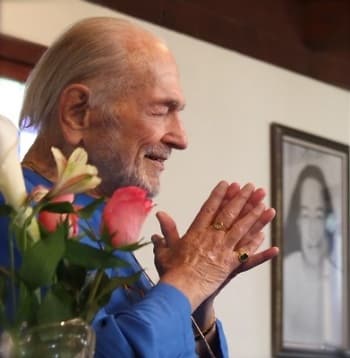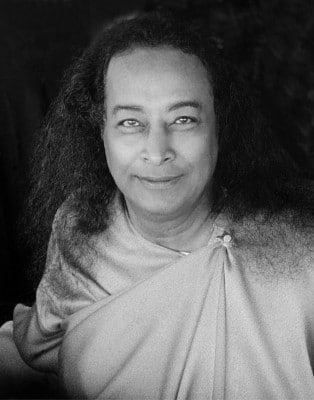When I first began to study Swami Kriyananda’s lectures and writings, I was struck by his supreme emphasis on a disciple’s attunement to the guru if the disciple is to attain the state of Self-realization.
In his wonderful book Paramhansa Yogananda: A Biography, (around which this article revolves), Swamiji writes about the importance of attunement as follows:
One difference I noted in him [Yogananda] between when he was with us and when he was with the public was that, when he was with the disciples, he spoke more about the importance of attunement with the guru than even about personal spiritual practices like Kriya Yoga. The first chapter of the Gospel of St. John states, “As many as received him, to them gave he power to become the sons of God.” By “received him” much more was meant than mere belief in Jesus Christ. “Received him” meant deep inner attunement with the Savior’s consciousness.
It is not possible for the ego to rise out of ego consciousness by self-effort alone. Swami KriyanandaIt is not possible for the ego to rise out of ego-consciousness by self-effort alone. Every struggle to do so only twists around to affirm that lesser consciousness yet again. Only by attunement with a true guru, who has himself transcended ego altogether, can one understand what it means to see things no longer with a personal bias. Without a guru, it is impossible for techniques by themselves to raise one out of this final, and most fundamental, delusion: that we are each a separate reality, distinct and separate from all others.
Tools for Attuning to the Guru’s Consciousness
Learning to attune to the guru’s consciousness ever more sensitively is the journey of a lifetime. Both Yogananda and Kriyananda have given us many practical tools for tuning into the guru’s consciousness. Some of these we know quite well.

- Frequently studying and meditating on the guru’s teachings.
- Practicing guru-given meditation techniques with deep devotion and regularity.
- Calling upon the guru during meditation and at other times.
- Visualizing the guru’s eyes and calling to him deeply, Introduce me to God.
- Asking, in every circumstance, What would my Guru have me do?
- Being in harmonious contact with other deeply attuned disciples of the guru.
Each of these tools is worthy of a separate blog post. In this article, I share another delightful way to tune into Yogananda’s consciousness that was given to us in Kriyananda’s Paramhansa Yogananda: A Biography.
The Guru’s personality: A window into the state of Self-realization
A Self-realized soul, even though firmly established in their soul-consciousness, dons a human personality when he incarnates on the physical plane. Yogananda explained this to Swamiji as follows:

Before taking a physical body, I see the personality I am to assume and feel slightly uncomfortable with it. It is like having to put on a heavy overcoat on a hot day. I soon get used to it, but inwardly I never forget that this personality is not my true Self. — The New Path
As Yogananda notes, a Self-realized soul is always cognizant of their true Self. Consequently, all aspects of their existence become spiritualized: Even their “human” personality manifests the qualities that reflect their superhuman state of Self-realization. We can therefore draw closer to the state of Self-realization by sensitive attunement to the personality of a Self-realized soul, and, in particular, our own guru.
Swami Kriyananda’s Paramhansa Yogananda: A Biography has a fascinating chapter called “Yogananda’s Salient Characteristics.” In that chapter Swamiji lists 32 characteristics of Yogananda’s personality, making it a veritable goldmine for attuning to this Great Soul. As it happened, this particular chapter and this book have played a very personal part in my own discipleship.
“Why does Swami Kriyananda read the same chapter!?”
 Swamiji wrote this book in 2011, in India, shortly before I came to him as a monk. He had just finished the book and was beginning a promotional tour when I joined the Pune monastery. Wherever he went –public lectures in many cities in India and the US, during informal teas and satsangs – Swamiji enthusiastically read from this book, as was his practice after the completion of a new work. To my supreme astonishment, in each of these settings, he read from the same chapter! Swamiji would always say, “And now let me read to you from this book and from the chapter Yogananda’s Salient Characteristics.”
Swamiji wrote this book in 2011, in India, shortly before I came to him as a monk. He had just finished the book and was beginning a promotional tour when I joined the Pune monastery. Wherever he went –public lectures in many cities in India and the US, during informal teas and satsangs – Swamiji enthusiastically read from this book, as was his practice after the completion of a new work. To my supreme astonishment, in each of these settings, he read from the same chapter! Swamiji would always say, “And now let me read to you from this book and from the chapter Yogananda’s Salient Characteristics.”
It was very difficult for me to understand why Swamiji always read that one chapter. The book had other more important chapters (in my opinion); for example, the chapter on Kriya Yoga. “Swamiji must be waxing nostalgic about his guru. That’s why he keeps reading all those characteristics of the human personality of Paramhansa Yogananda,” I thought at that time, greenhorn that I was on the spiritual path (which I think I still am!). It was only years later that I realized that Swamiji perhaps was driving home the importance of studying our Guru’s personality as a way of tuning into his consciousness.
I’ve often studied that chapter since, and it’s given me many valuable guidelines for sculpting my own personality so that it may manifest more of my soul nature and less of my ego. Let me share with you a few characteristics from the 32 that Swamiji lists in the chapter:
- The outstanding trait I observed was his complete absence of ego.
- Another trait that always amazed me in him was the deep, impersonal respect he gave everyone.
- He had an impish and utterly delightful sense of humor.
- He treated all people equally and was as respectful toward any garage mechanic as toward someone prominent in the world of politics, business, or the arts.
- He was surprisingly innovative. He built, as far as I know, the first motor home. He called it a house car and used it to travel about the country lecturing.
- Another fact I noticed about him was that he was completely positive.
- Nothing ever excited him. Always, he was deeply calm. He could laugh. He could, when he had to, move quickly. Nevertheless, he was always calm.
- He was deeply loving to all and concerned for their well-being.
- He had great divine power, as we saw in the story of that thug who menaced him in Lakeside Park, Chicago. Yet he was respectful toward, even appreciative of, others’ opinions, even when these differed widely from his own.
- His generosity extended far beyond mere money or material gifts. It also included allowing others to have the last word—deferring to their opinions and applauding whatever good they did.
- His nature was enthusiastic, but never “bouncy.” He never reacted emotionally to anything. His enthusiasm was always an expression of his bliss in God.
- He never judged anyone—judgment he left to God. He was truly a friend to all.
Aren’t these qualities worth assimilating into ourselves? The last characteristic in the list above is perhaps my favorite to try and emulate. It is so easy in today’s competitive world to forget that one of the highest purposes of life is to befriend, appreciate, and help others. I have mentioned only some of the 32 characteristics. In the actual chapter, Swamiji elaborates on many of them with examples and discussion.
Learn to behave. Swami Sri YukteswarYogananda said that his guru, Swami Sri Yukteswar, often admonished him: “Learn to behave.” Our personalities are tell-tale indicators of our true spiritual progress, far more than the hours we can meditate daily. We can rapidly advance toward Self-realization by refining our personalities. This is done most easily by tuning into the personality of the guru.
The Imitation of Yogananda
On January 5, the occasion of our Guru’s birth, I invite you to read this chapter as a wonderful opportunity for attunement. Choose qualities that you feel you would like to, or need to develop. If you feel you’re judgmental by nature, choose to be a friend to all. If you’re bouncy, learn to be more withdrawn. If you are low-energy, learn to exhibit power and magnetism in your posture and voice. The possibilities for spiritual progress are endless and exciting–as happens when we’re in tune with a true guru.
 This chapter is a way to practice The Imitation of Paramhansa Yogananda. This is what Thomas à Kempis meant when he called his book The Imitation of Christ. He didn’t intend for us to parrot Christ blindly. He was saying that by sensitively tuning into Christ’s consciousness, we can strive to imitate Christ’s example of living in this world as a completely free soul. Swamiji remarks about The Imitation of Christ:
This chapter is a way to practice The Imitation of Paramhansa Yogananda. This is what Thomas à Kempis meant when he called his book The Imitation of Christ. He didn’t intend for us to parrot Christ blindly. He was saying that by sensitively tuning into Christ’s consciousness, we can strive to imitate Christ’s example of living in this world as a completely free soul. Swamiji remarks about The Imitation of Christ:
Master had given me and others for Christmas a copy of The Imitation of Christ. When I thanked him, he said, “That is a wonderful book. It is no mere imitation of Christ: It is Christ. I don’t often encourage people to read other books, but this one I recommend unreservedly.” Swamiji commented to Yogananda that Kempis must have been a great saint and Yogananda affirmed, “A very great saint.”
This year, by deeply tuning into Yogananda’s consciousness, may we also become more Christ-like ourselves.

See Crystal Clarity Publishers for Paramhansa Yogananda: A Biography

11 Comments
Jai, thanks, Sagar!
Sagar, thank you. This is a deeply moving article. I am so grateful to you for sharing these thoughts. So enlightening, I read it out loud to my family, who also greatly appreciated your insight and observations, along with suggestions. In Master, Luba.
Hello Sagar ,
I enjoyed reading your article “ The imitation of Yogananda “ very much .
It’s very inspiring and points clearly how we can work upon ourselves to transcend the ego !
Joy to you , promilla.
What a wonderful reminder! I am looking forward to reading chapter 17 in Master’s biography by Swamiji!
Thank you Sagar
Sagar,
I am in deep appreciation for your article. I have the book, have read it yet your article has inspired me to reopen and look at this chapter in a new way. For Swami Kriyananda to read this one chapter over and over to all audiences brings an understanding to not take this chapter lightly. Thank you for opening my eyes ina new way
Very nice article. Thank you for the reminder about this chapter and the jewels it holds for us to study and implement.
Sagarji, your tones and wisdom grow more sublime and a delectable treat to read and as a guide for spiritual seeking souls. Thank you for this wonderful article.
What an enlightening article…enjoyed it so much. Will definitely be reading the books mentioned.
Thanks Br Sagar!
The Article is an insight into Master’s outstanding Spiritual personality and inspiration to all of us. Even more, Sagar has emphasised how Swami Kriyananda was a living example of being an unflinching loyal Disciple.
ATTUNEMENT TO OUR GURU IS THE KEY.
Hello Sagar! What a timely reminder to listen to this chapter (perhaps the entire book) again! While reading your article, two things have touched me deeply…. Master’s deep joy in God coupled with His eyes in the first photo and then His complete lack of ego and then looking into His eyes in the last photo 🙏